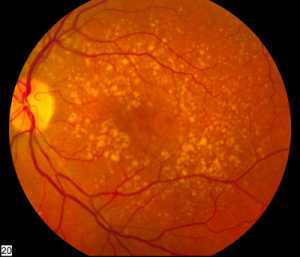
25 Aug Over 20% of Macular Degeneration Patients Lost to Followup After Treatment
MedicalResearch.com Interview with:

Picture of the back of the eye showing intermediate age-related macular degeneration: Wikipedia image
Jason Hsu, MD
Retina Service, Wills Eye Hospital
Associate Professor of Ophthalmology
Thomas Jefferson University
Mid Atlantic Retina
Anthony Obeid MD MPH
School of Public Health
The University of Sydney ·
MedicalResearch.com: What is the background for this study? What are the main findings?
Response: Neovascular age-related macular degeneration (nAMD) is a vision-threatening disease that often afflicts elderly patients. The introduction of intravitreal anti-vascular endothelial growth factor treatment drastically improved the prognosis of eyes with nAMD. Despite its efficacy, patients require consistent follow-up (sometimes as often as monthly), with ongoing injections to maintain the visual benefits of the drug. Unfortunately, few studies have reported the number of patients that do not follow-up with recommended guidelines. Moreover, there remains limited evidence on the risk factors associated with loss to follow-up.
Our study, consisting of 9007 patients with a history of nAMD receiving treatment between 2012 and 2016, evaluated both these parameters. We defined loss to follow-up as having at least one injection without a subsequent follow-up visit within 12 months post-treatment.
Using this definition, we found that over 20% of patients are lost to follow-up over the entire study period. We further identified key risk factors associated with loss to follow-up, which included patients of older age, race, patients residing in a region of a lower average adjusted gross income, patients living at greater distances from clinic, patients with active nAMD in only one eye, and patients with worse visual acuity.
MedicalResearch.com: What should readers take away from your report?
Response: Physicians often surmise that patients with nAMD are strictly compliant with follow-up, at least relative to other diseases involving the retina with similar treatment regimens.
The results of our study appear to suggest that this might not necessarily be true, and loss to follow-up remains a significant concern in patients with nAMD. We believe it is important for practices to develop a tracking system for these patients to try to improve compliance with follow-up whenever possible.
MedicalResearch.com: What recommendations do you have for future research as a result of this work?
Response: Given the sequelae of loss to follow-up on visual acuity outcomes, it is important that we further evaluate its risk factors to build more robust models that help in predicting high-risk patients prior to them being lost to follow-up. Our hope is that this will allow us to design an intervention while the patient is in the office that may help to improve follow-up compliance.
We have no relevant financial disclosures.
Citation:
[wysija_form id=”3″]
[last-modified]
The information on MedicalResearch.com is provided for educational purposes only, and is in no way intended to diagnose, cure, or treat any medical or other condition. Always seek the advice of your physician or other qualified health and ask your doctor any questions you may have regarding a medical condition. In addition to all other limitations and disclaimers in this agreement, service provider and its third party providers disclaim any liability or loss in connection with the content provided on this website.
Last Updated on August 25, 2018 by Marie Benz MD FAAD
